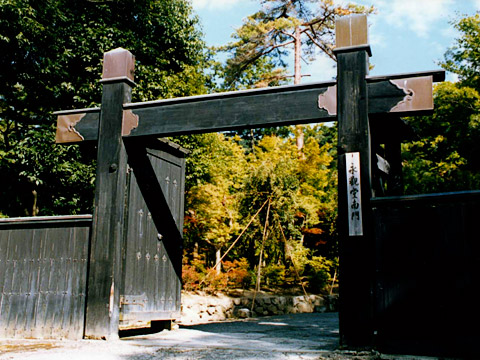|
||
 |
||

Eikandou
Minamimon 永観堂南門 (Kyoto)
(C)2001 Japanese Architecture and Art Net Users System. No reproduction or republication without written permission.
掲載のテキスト・写真・イラストなど、全てのコンテンツの無断複製・転載を禁じます。
|
||||||
| kabukimon 冠木門 | ||||||
| KEY WORD : architecture / gates | ||||||
| Also
written koumon 衡門. A roofless gate composed of two square gate posts
*hashira 柱, either
set directly into the ground *hottatebashira
堀立柱, or placed on square base stones, nemaki-ishi 根巻石 (see *nemaki
根巻). A heavy horizontal beam or lintel, called *kabuki
冠木, is inserted into the posts. Usually small timbers are placed across
the under side of the kabuki beam and sometimes vertically against
the inner sides of the posts into which the gate doors are attached. Sometimes
the gate doors are secured directly to the posts themselves. The doors open
inward. The top side of the door is straight. Occasionally the door is hung
with a space between the door bottom and the ground sill, not only for aesthetic
reasons but to prevent water from heavy rains collecting under the doors.
The doors are made of heavy vertical planks and are attached to the posts
with decorative hinges called *hassou
kanagu 八双金具. The doors may have metal decoration called manjuu
kanamono 饅頭金物 (see *manjuugata 饅頭形). The tops of the posts are pyramidal in shape and are
called tokin 兜巾. The band around the tops of the posts and around
the kabuki lintel are called *fukurin
覆輪. The posts often are supported on the inner face by an arrangement of
props or secondary posts called *hikaebashira
控柱 which are connected to the posts with diagonal tie beams and a lower
straight tie beam. Kabukimon may also have a small side door called
kowakitobira 小脇扉 attached to one of the posts of the gate. This type
of gate dates back to the Kamakura period and was used by low
ranking people. By the Muromachi period, it was used at warriors
mansions and as a castle gates. The use of this type of gate for residences
increased during the Edo period. |
||||||
 Eikandou
Minamimon 永観堂南門 (Kyoto)
|
||||||
| REFERENCES: | ||||||
| *kuginukimon 釘貫門 | ||||||
| EXTERNAL LINKS: | ||||||
| NOTES: | ||||||
(C)2001 Japanese Architecture and Art Net Users System. No reproduction or republication without written permission. 掲載のテキスト・写真・イラストなど、全てのコンテンツの無断複製・転載を禁じます。 |
||||||